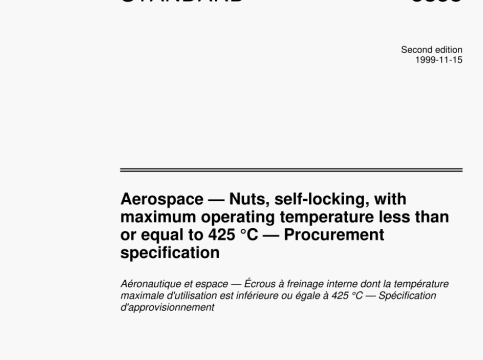ISO 5858 pdf download – Aerospace -Nuts, self-locking, with maximum operating temperature less thanor equal to 425 °C- Procurement specification.
4.2 Qualification inspection and test conditions
Ouakfication Wpections and tests (re.iiromerlls, methods. numbers of nuts) are specified Nt Table 1. They shall be carried out on:
— each type and diameter of nut;
— 100 nuts selected from a single batch by simple random sampling.
The test programme may possiy be reduced, or quaiificatmn of a nut granted, without inspection or testing; any such decision shall be based on the results obtained on similar types arid diameters of nuts provided that the design and manufacturing conditions are identical.
The inspections and tests shall be repealed on any nut if the supplier or the manufacturing conditions have changed.
Qualification inspections and tests are summarized in Table 2.
4.3 Production acceptance inspection and test conditions
Production accepLance inspections and tests (requirements, methods, numbers of nuts) are specified in Table 1. They shall be carnod out on each batch. Nuts from the batch to be tested shall be selected by simple random sampling.
Each nut may be subjected to several inspections or tests.
The nuts to be subjected to destructive inspections or tests may be those on which non-destructive inspections or tests have been carried out.
If a more stringent inspection is deemed necessary, all or part of the qualification inspections and tests may be performed during the production acceptance inspections and testing. In this case, the number of nuts submitted is the same as that submitted for qualification inspections and tests
Batches declared unacceptable after the production acceptance inspections and tests shall be submitted for me- inspection or testing only after all the detective units have been removed andor defects have been corrected. In this case, the attribute(s) which caused the meeclion shall be verified using a sample of twice the normal size with the same number of defective items acceptable
Production acceptance inspections and tests are summarized In Talle 2.
4.4 Use of “statistical process control (SPC)”
Where a characteristic is obtained by a controlled statistical process, the mnanulacturer has the possibility, in order to declare conformity of the characteristic, of refraining from the final systematic sampling provided for In this International Standard, if he is capable of formally justifying this choice by using ISQTR 13425 and the standards quoted in it as a basis.
use of control charts for data consolidation;
determination of the audits to be run and the control to be carried out to ensure reliability of the device.
To be usable in production, this process shall have been validated beforehand by the qualifying body, either duringthe qualification phase, or a posteriori according to the case, by analysing the justificatory file and the results of thequalification inspections such as provided for in clause 5.
5 Technical requirements
The technical requirements of this International Standard are given in Table 1.
They complement the requirements of all other standards or specifications referenced in the definition document forthe nut.
NOTE The attention of the users of this International Standard is drawn to the fact that if there is no International Standardspecifying the method to be used, a prior agreement is necessary between the user and the manufacturer with respect to thefollowing inspections and tests:
spectrographic analysis or spectroscopic analysis of the malterial (see 5.1.1);micragraphic inspection of the structure of the material (see 5.1.2y;
inspecion tor carburization or decarburization (see 5.1.3);
magnetoscopic inspection for surlace discontinuities (see 5.1.4);magnetic permeability inspection (see 5.1.6);
inspection by chemical reagent to determmine type of surface coating (see 5.2.2);
tactile inspection or inspection using a profilometer to determine surface roughness (see 5.3.2).
ISO 5858 pdf download – Aerospace -Nuts, self-locking, with maximum operating temperature less thanor equal to 425 °C- Procurement specification
